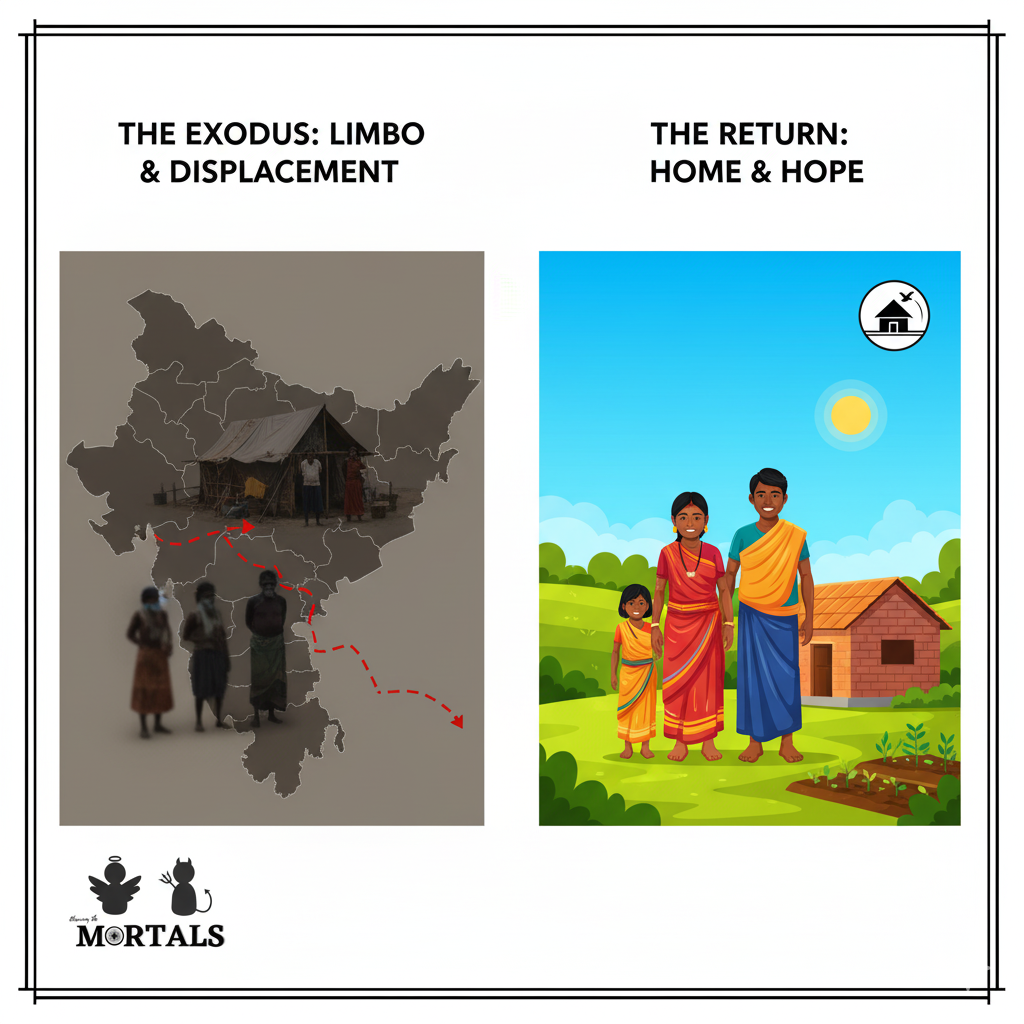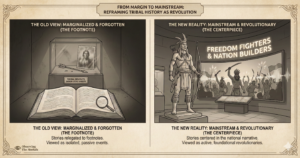When we think of refugees, we often picture people crossing international borders to flee a war. But what about those who become refugees in their own country, displaced by a conflict simmering within? Nearly two decades ago, tens of thousands of Adivasi families fled their ancestral villages in Chhattisgarh, caught in the brutal crossfire between Maoist insurgents and state-backed security forces. They became “nowhere people,” living in a state of limbo in neighbouring states. Now, a powerful intervention by the National Commission for Scheduled Tribes (NCST) is forcing the government to finally confront this forgotten exodus and create a pathway for these citizens to come home.
The Information Box
Syllabus Connection:
- Paper 2: Chapter 6.1 (Problems of Tribal Communities: Displacement), Chapter 6.2 (Tribal Administration: NCST), Chapter 7 (Role of Anthropology in Tribal Development)
- Paper 1: Chapter 9 (Applied Anthropology), Chapter 4 (Political Anthropology)
Key Concepts/Tags:
- Internally Displaced Persons (IDPs), Conflict-Induced Displacement, NCST, Rehabilitation Policy, Bru Resettlement, Chhattisgarh
The Setting: Who, What, Where?
This case study is centered on the plight of Scheduled Tribe families who were internally displaced from the Bastar region of Chhattisgarh around 2005, during the peak of the Maoist conflict and the controversial Salwa Judum anti-Maoist movement. The key actor pushing for a resolution is the National Commission for Scheduled Tribes (NCST), a constitutional body. It is responding to a representation from Valasa Adhivasula Samaikya, an association representing the displaced families, a majority of whom are now living in neighbouring states like Telangana and Andhra Pradesh, often without proper documentation or access to their rights.
The Core Argument: Why This Study Matters
This is not just about a local issue; it’s a critical case study on state responsibility, rehabilitation, and the long-term consequences of internal conflict.
- Acknowledging “Conflict-Induced Displacement”: The NCST’s intervention is significant because it forces the state to formally acknowledge and create a dedicated policy for a specific, often-neglected category of displacement. Unlike victims of a dam or a mine, these are victims of a protracted, low-intensity war, and their path to rehabilitation is fraught with unique challenges of security and social reintegration.
- A Comprehensive, Rights-Based Rehabilitation Model: The NCST’s recommendation sets a high benchmark for what just rehabilitation should entail. It is not just a token compensation package but a holistic, rights-based plan that includes:
- Land: A specific amount for both agriculture (not less than 5 acres) and housing (under PMAY).
- Livelihoods: A provision for employment.
- Rights & Entitlements: Issuance of community certificates and ration cards.
- Infrastructure: Ensuring schools, healthcare centres, and anganwadis in their new habitations.
- The Power of Precedent (The Bru Model): The explicit instruction for the Chhattisgarh government to study and draw from the 2018 Bru resettlement plan is a crucial piece of policy analysis. It shows an attempt at institutional learning, using the framework of a previous, large-scale rehabilitation effort for another conflict-displaced tribal group to inform a new policy.
- The “Battle of the Surveys”: The case highlights a classic governance problem. The official government surveys identified about 3,300 displaced families, while an independent survey by the community association found over 9,600. This huge discrepancy underscores the state’s tendency to underestimate the scale of such problems and validates the need to take community-led data seriously.
The Anthropologist’s Gaze: A Critical Perspective
- The Deep Trauma of “Return”: An anthropologist would argue that a successful policy must go beyond the logistics of physical relocation. What does it mean to “return” after two decades? A new generation has been born in exile, ancestral villages may be destroyed, and social networks shattered. The policy must address the immense psychological and social trauma of displacement and the profound challenges of community reintegration, not just provide land and houses.
- Land as Identity, Not Just an Asset: While the NCST’s recommendation for “5 acres” is a concrete policy step, an anthropological view would emphasize that for Adivasi communities, land is not just an economic asset. It is the basis of their social, cultural, and religious identity. The rehabilitation process must respect this, ensuring that land allocation allows for the re-establishment of community life and addresses their rights over common property resources, as mandated by the Forest Rights Act.
- The Politics of Enumeration: The conflict over the number of displaced families is not just a statistical error; it’s a political act. From the state’s perspective, a lower number means less financial and administrative burden. For the community association, a higher, more accurate number is a tool for claiming greater political recognition and resources. An anthropologist would see this “battle of the surveys” as a struggle for legitimacy and the power to define the very scale of the problem.
The Exam Angle: How to Use This in Your Mains Answer
- Types of Questions Where It can be Used:
- “Displacement is one of the most severe problems faced by tribal communities in India. Discuss its various causes and consequences.”
- “Analyze the role of the National Commission for Scheduled Tribes (NCST) in safeguarding tribal rights.”
- GS-3 (Internal Security): “What are the non-military measures required for resolving the LWE conflict?”
- Model Integration:
- On Tribal Displacement (Paper 2): “Beyond development projects, a significant but often overlooked cause of tribal displacement is internal conflict. The recent push by the NCST for a dedicated policy to rehabilitate Adivasis who fled the Maoist conflict in Chhattisgarh nearly two decades ago highlights this long-neglected issue of Internally Displaced Persons (IDPs).”
- On Rehabilitation Policy: “A just rehabilitation policy must be comprehensive and rights-based. The NCST’s recommendation for Chhattisgarh’s displaced tribals—which includes specific provisions for land, housing, and employment, and draws from the precedent of the Bru resettlement plan—provides a robust model for such state interventions.”
- For GS-3/Internal Security: “A key non-military aspect of resolving internal conflicts is the just rehabilitation of displaced civilian populations. The NCST’s directive to the Chhattisgarh government to frame a policy for tribals who fled the Maoist conflict is a crucial step towards healing the deep social wounds of the conflict and restoring the state’s legitimacy among affected communities.”
Observer’s Take
The NCST’s intervention is a powerful reminder that the casualties of conflict are not just those who lose their lives, but also those who lose their homes, their lands, and their place in the world. For nearly two decades, thousands of Adivasi families have been the forgotten victims of the Maoist conflict, living as refugees in their own country. The call to bring them home, using the hard-won lessons from the Bru resettlement, is more than a policy directive; it’s an act of restorative justice. This is a critical test of whether the state can move beyond simply fighting a conflict and begin the long, difficult, and necessary work of healing the communities it has torn apart.





